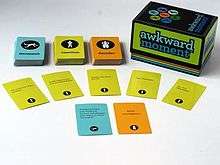Awkward Moment
Awkward Moment® is a party game that puts 3-8 players in awkward social situations. It was developed by the Tiltfactor Lab as part of a National Science Foundation-funded project called “Transforming Science, Technology, Engineering, and Math (STEM) For Women and Girls: Reworking Stereotypes & Bias.”[1][2] It is a 20 minute game for middle and high school students (ages 12 and up). The game won Meaningful Play's best non-digital game award in 2012.[3]

Gameplay
Players take turns assuming the role of the Decider. The Decider reveals a Moment Card that describes a funny, embarrassing, or stressful situation for the group and a Decider Card that provides a guideline for choosing a winning Reaction. Players submit a Reaction Card from their hand face down, and the Decider selects the Reaction Card that he/she thinks is the best response to the Moment, given the Decider Card's rule.[4]
Research
Awkward Moment challenges players to consider other's viewpoints and assess their own biases.[5] Data suggests that Awkward Moment strengthens associations between women and STEM and reduces people's trained biases.[6][7]
Versions
Awkward Moment at Work was released in 2015 and focuses on awkward workplace situations.
References
- "Tiltfactor "Pox," "Buffalo," and "Awkward Moment"". Different Games Conference. Archived from the original on 2013-11-09.
- Barber, Bonnie. "Professor Mary Flanagan Participates in White House Consortium". Dartmouth Now. Archived from the original on 4 September 2013. Retrieved 17 September 2013.
- "2012 Meaningful Play Awards".
- Kalajian Jr., Robert. "Toy Fair 2013-Tiltfactor". Purple Pawn. Retrieved 12 October 2013.
- Dixon, Drew. "Bit Creature blog post". Retrieved 12 October 2013.
- Alexander, Leigh. "How can games contain and convey values?". Gamasutra. Retrieved 16 August 2013.
- "Creating Values from Play - Tiltfactor". Classroom Aid. Retrieved 17 September 2013.